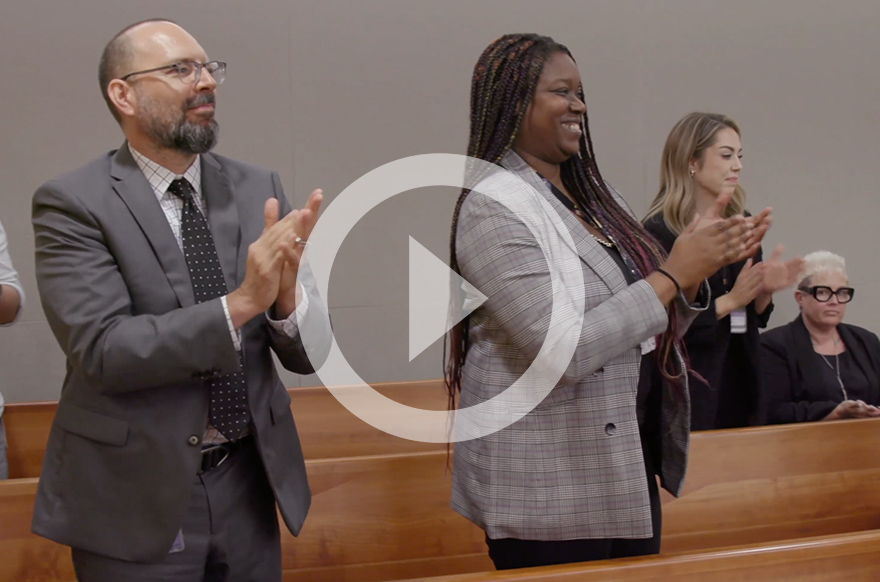Community Assistance,
Recovery and
Empowerment (CARE) Act
A new California tool that helps people with schizophrenia
Community Assistance,
Recovery and
Empowerment (CARE) Act
A new California tool that helps people with schizophrenia
If you or someone you know is living with schizophrenia and stuck in a cycle — in and out of hospitals, living without a stable home, getting in legal trouble, or experiencing other issues — the CARE Act may offer a new way to get help.
It offers you a team who will be there every step of the way. They are responsible for listening to your goals and helping get you mental health care, substance use treatment, a safe place to live, and medicine that helps you feel better. Your voice and your choices are a key part of the plan.
The CARE Act offers a compassionate and supportive path to stability and recovery.
Stay Updated
Updates, Videos, Fact Sheets and More
The CARE Act Working Group
See meeting information, schedules, materials and recordings.
Join the E-Mail List
Get regular updates via the CARE Act listserv by sending an email to CAREACT@chhs.ca.gov.
New Videos:
The CARE Act at Work
Our new video series shows the real-world impact of the CARE Act.
An Introduction to the CARE Act
How the CARE Process Works
CARE is a pathway to safety and well-being for people with schizophrenia who may be in a cycle of hospitalization, homelessness, and jail. CARE breaks the cycle and ensures personalized services, housing, and medication.
An essential part of the process is building trust. CARE connects the person who needs help with a team of people who want them to succeed. It uses a special civil court that protects their rights and focuses on progress instead of punishment.
Here is how the CARE Act can work for someone who has untreated or undertreated schizophrenia or a related disorder:
1. Petition
A family member, first responder, doctor, therapist, medical professional or person themselves submits a petition to the CARE court. The CARE court is not a criminal court. It was created especially for this process and to support people during their recovery.
2. Engagement and Evaluation
If a CARE judge thinks the person is or may be eligible for CARE, a county health team will meet with the person to understand their situation. (Here’s who is eligible for the CARE process.)
The county health team reports back to the judge within 30 days. If the judge agrees that the person qualifies for the process, everyone works together to make a plan or agreement.
3. CARE Agreement/CARE Plan
The person who needs support, their lawyer (who is provided to them at no charge), and the county health team work together to create a CARE plan or agreement. It is designed with the person, and just for them. Their voice and choices are an important part of the process.
The plan or agreement can include counseling or therapy, medicine to help them manage symptoms, and a plan for a safe place to live. Finding housing is often an essential part of the plan.
A judge must review and approve the plan or agreement to make it official.
4. Support
Once the plan or agreement starts, the county health team ensures the services are available and helps the person get what they need. The person will meet with the team and the judge regularly to talk about how they are doing.
The CARE plan or agreement usually lasts for one year. If more time is needed, it can be extended up to an additional year.
5. Graduation
When a person successfully finishes their plan or agreement, they “graduate” from the CARE program in court.
After graduating, they can still get help with treatment, housing, and other services to support their long-term health.
They can also create a Psychiatric Advance Directive, which is a document of their wishes for future medical care in case they have a mental health crisis again.
A New Approach to Mental Health
The CARE Act represents a major change in how California addresses severe mental illness. It is a civil court process, not a criminal one, designed to provide compassionate and effective support. It connects participants with a set of community-based services that are medically appropriate and respect their cultural background and language.
What is a CARE Plan?
A CARE Plan or agreement is an individualized strategy for a person’s recovery. These plans or agreements are structured to last up to one year and can be extended for an additional year if needed. The goal is to provide a wide range of support, which may include:
- Short-term stabilizing medications
- Wellness and recovery coaching
- Connections to social services, especially housing
Housing is a critical part of a successful CARE plan or agreement. It’s recognized that achieving stability and staying engaged with treatment is nearly impossible for individuals living on the streets, in a tent, or in a vehicle.
An Early Intervention to Prevent Crisis
The CARE process is designed as an “upstream” intervention. Its purpose is to help people before they are placed in more restrictive situations, such as a conservatorship (where they lose the right to make their own decisions) or jail. Evidence shows that many people can stabilize and heal in less restrictive, community-based settings. With modern treatment options, including new long-acting medications, and the right support team and housing, individuals who have suffered on the streets or through unnecessary incarceration can be successfully supported in their communities.
Who Is the CARE Act For?
It’s important to understand that CARE is not for every person experiencing homelessness or mental illness. The process is specifically focused on individuals with schizophrenia spectrum disorders or other similar psychotic disorders who meet strict criteria. The goal is to reach these individuals before they are arrested, sent to a State Hospital, or become so impaired that they are placed under a Lanterman-Petris-Short (LPS) Mental Health Conservatorship. CARE may also be the right next step for someone after a short-term involuntary hospital stay (like a 72-hour or 14-day hold) or for those who can be safely diverted from the criminal justice system. The CARE Act aims to connect California’s most vulnerable residents who have treatable conditions with a clear path toward long-term recovery.
The CARE Process and Participant Support
The CARE process begins when someone, such as a family member, healthcare provider, or first responder, files a petition with the court. From the start, participants are provided with key support to protect their rights and help them navigate the process:
- Legal Counsel: Every participant is provided with a lawyer.
- A Voluntary Supporter: The participant can choose a trusted person to act as a supporter. The supporter’s role is to help the participant understand their options, consider choices, and communicate their decisions. This empowers the participant to make their own self-directed choices whenever possible.
The CARE Plan ensures all necessary services, from clinical treatment to housing, are identified and coordinated. To further protect a participant’s independence, they are encouraged to create a Psychiatric Advance Directive. This is a legal document that allows them to state their preferences for treatment in advance, ensuring their wishes are known in the event of a future mental health crisis.
In the CARE Process, Everyone Has a Responsibility
The CARE Act is designed to make sure that everyone involved is held responsible. This accountability works both ways—it applies to the person receiving help and to the local government providing it.
Responsibility of Local Government
The CARE Act also holds county governments accountable for providing the care that people need. They are expected to use the many sources of money already available to them. These funds include:
More than $10 billion every year for mental and behavioral health care from sources like the Mental Health Services Act.
Over $15 billion in state funding made available in the last several years to fight homelessness.
A $1.5 billion program for “bridge housing,” which provides temporary housing and support services. People in the CARE process will be given priority for this type of housing.
If a county fails to provide the services required by a court-ordered CARE plan or agreement, it will face consequences. The court has the power to order penalties, such as fines. In serious cases, the court can even appoint an outside manager to take over and make sure the person receives the care they were promised.
Detailed Information
- The law that created the CARE Act: SB 1338
- Welfare and Institutions Code (WIC) CARE Provisions, The CARE Act at a Glance
- CARE Act Fact Sheet: English/Spanish
- Policy Brief: Understanding California’s Recent Behavioral Health Reform Efforts: English/ Spanish
Funding Details


